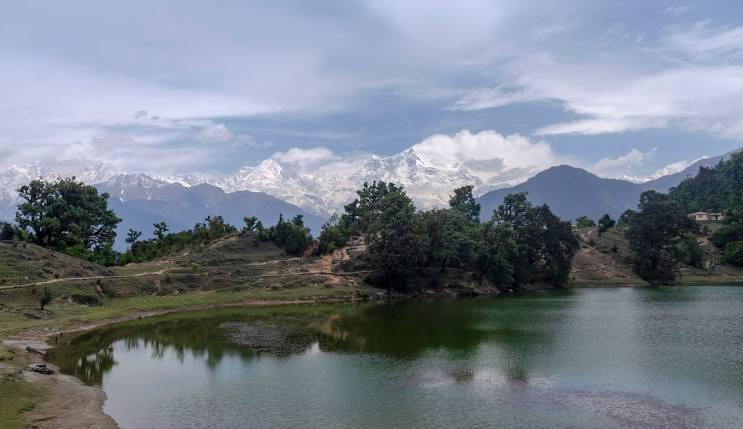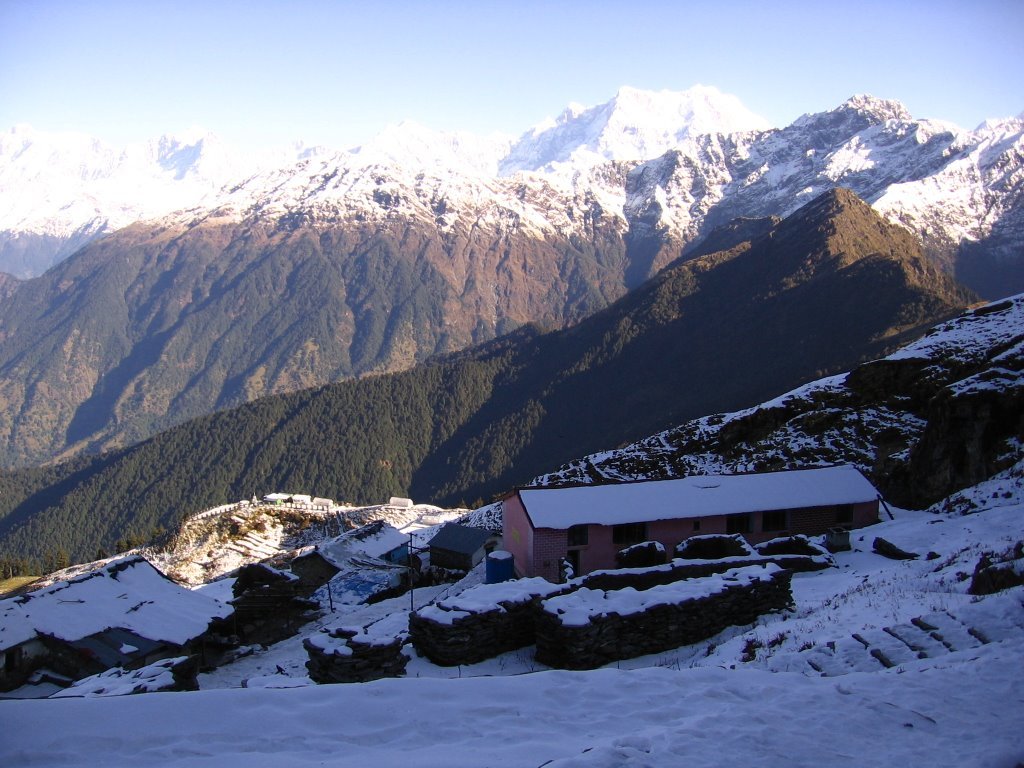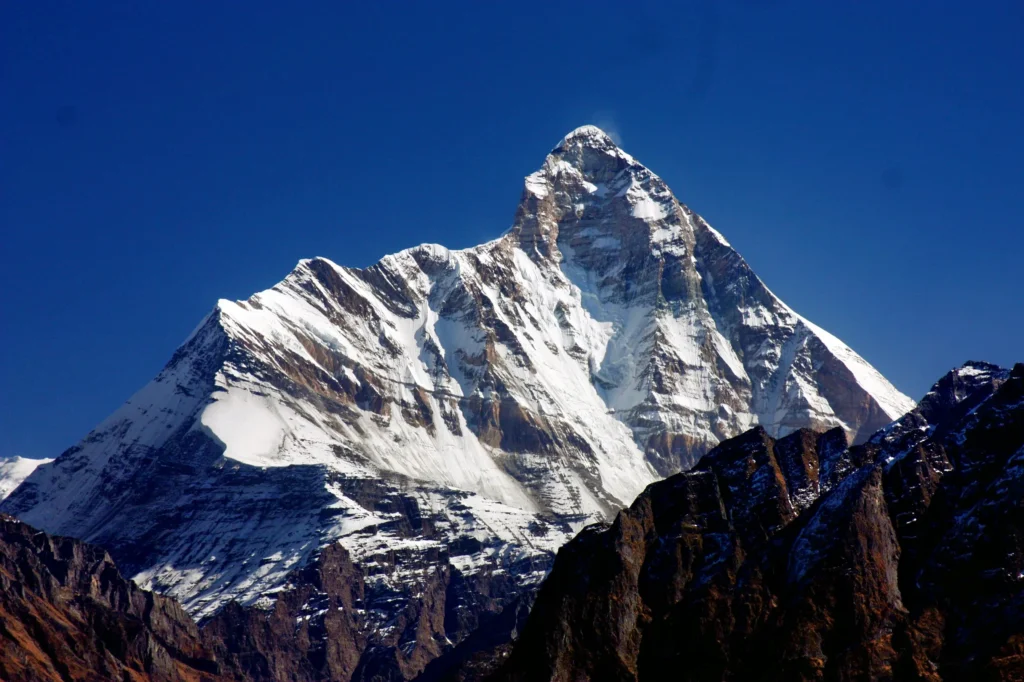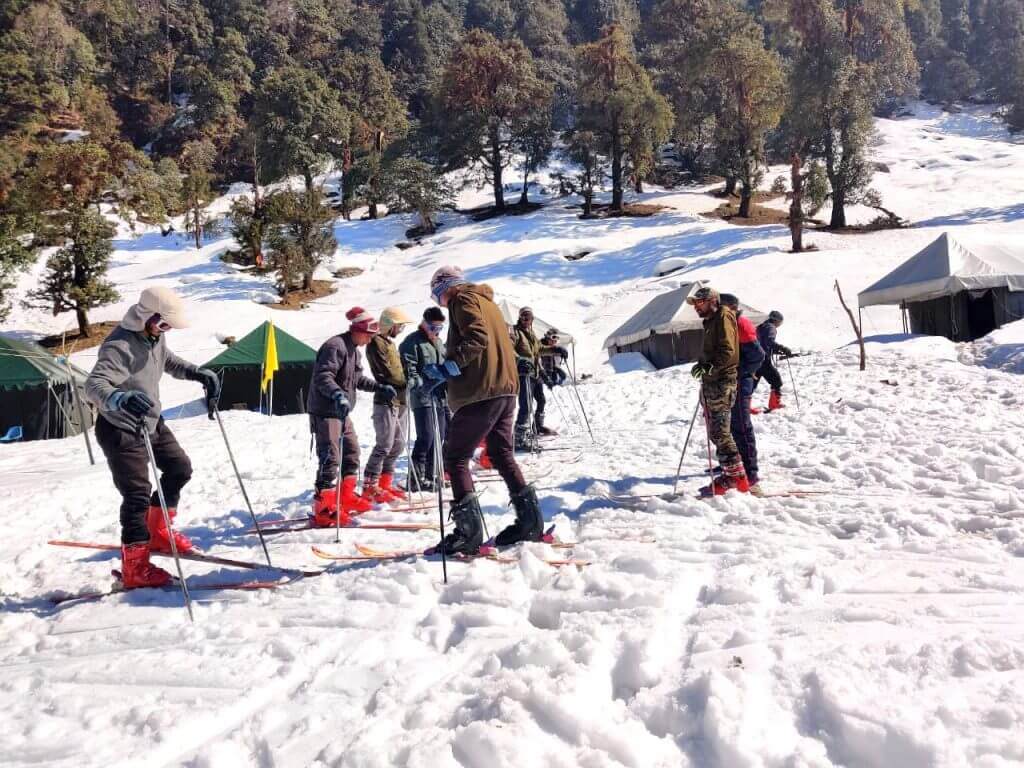Chopta Trekking Best Time To Visit
Published on November 06, 2024
The Ultimate Guide to Chopta Trekking: Best Time to Visit for Every Season
Chopta, a picturesque destination in Uttarakhand, offers unique trekking experiences throughout the year. Spring (March to May) unveils vibrant meadows and blooming wildflowers, making it a prime time for Chopta trekking tour packages. Summer (June to August) provides pleasant weather ideal for high-altitude treks, including the famous Tungnath Temple Trek and Chandrashila Summit Trek, with clear skies and lush landscapes. Autumn (September to November) presents crisp air and panoramic views, perfect for trekking in comfortable conditions.
Winter (December to February) transforms the region into a snowy wonderland, offering a serene and magical trekking experience for those interested in winter trekking in Uttarakhand. This ultimate guide helps you choose the best time to visit Chopta based on seasonal highlights and trekking conditions.
Spring (March to May): The Blooming Beauty
Nestled in the serene landscapes of Uttarakhand, Chopta is often celebrated for its breathtaking vistas and lush meadows. The spring season, from March to May, unveils a particularly enchanting side of Chopta, making it an ideal time for Chopta camping packages. As the snow begins to melt, trekkers can enjoy the beauty of nature while exploring Chopta trekking tour packages. This period is arguably one of the best times to visit this Himalayan paradise, offering trekkers and nature enthusiasts a unique opportunity to experience its beauty in full bloom. This guide explores why spring is a perfect time to visit Chopta, detailing the best treks such as the Chopta Tungnath Trek, and tips for making the most of your visit.

The Arrival of Spring in Chopta
Weather and Conditions:
Spring in Chopta is characterized by a gradual transition from the cold winter to the warmer summer months. From March to May, the weather is generally mild and pleasant, making it ideal for budget Chopta packages. Daytime temperatures typically range between 10°C to 20°C (50°F to 68°F), while nighttime temperatures are cooler, dropping to around 5°C (41°F). The snow that covered the meadows and trails during winter begins to melt, revealing lush green landscapes and vibrant wildflowers. This is the Chopta Trekking Best Time To Visit, where travellers can enjoy the refreshing atmosphere.
The skies are usually clear, providing stunning views of the surrounding Himalayan peaks. The risk of rain is relatively low in March and April, though May might bring occasional pre-monsoon showers. Overall, the weather conditions during spring create an inviting environment for trekkers and nature lovers looking for the best trekking packages.

Flora and Fauna:
One of the most remarkable features of spring in Chopta is the explosion of colours across the meadows. The melting snow gives way to a profusion of wildflowers, including rhododendrons, orchids, and primroses. This vibrant atmosphere is ideal for those on Chopta camping packages, as they can immerse themselves in the breathtaking scenery. The blooming flowers attract various species of butterflies and birds, adding to the excitement for those trekking in the region.
.Chopta trekking tour packagesThe high-altitude meadows and forests are lush and green, with the rejuvenated vegetation offering a fresh and invigorating experience. Spring is also a time when the region's wildlife becomes more active, and spotting animals such as the Himalayan Monal, the state bird of Uttarakhand.
Best Treks in Spring
1. Deoriatal Trek
Overview:
The Deoriatal Trek is one of the most popular trekking routes in Chopta, and spring is the perfect time to undertake this journey with Chopta trekking tour packages. The trek leads to the pristine Deoriatal Lake, nestled amidst dense forests and meadows. The lake is renowned for its crystal-clear waters, which mirror the snow-capped peaks of the Chaukhamba range.

Highlights:
- Wildflower Meadows: During spring, the meadows surrounding Deoriatal Lake burst into a colourful display of wildflowers. The sight of these vibrant blooms against the backdrop of the serene lake and majestic peaks is truly breathtaking.
- Clear Reflections: The calm and clear waters of the lake reflect the surrounding mountains, providing excellent opportunities for photography.
- Pleasant Weather: The mild temperatures and clear skies make the trek enjoyable, with comfortable conditions for hiking and camping.
2. Tungnath and Chandrashila Trek
Overview:
The Tungnath and Chandrashila trek is another fantastic option during spring. This trek leads to the Tungnath Temple, the highest Shiva temple in the world, making it a must-see for pilgrims and trekkers alike, especially those looking for Tungnath Temple Trek experiences.

Highlights:
- Temple Visit: The trek includes a visit to the ancient Tungnath Temple, a significant pilgrimage site for Hindus and an important part of Himalayan treks.
- Blooming Trails: As you ascend, the trails are adorned with blooming rhododendrons and other wildflowers, adding a splash of colour to your journey.
- Stunning Views: From Chandrashila Peak, you can enjoy panoramic views of major Himalayan peaks, including Nanda Devi, Trishul, and Chaukhamba, perfect for those on Chopta trekking tour packages.
3. Ruthsura Meadows Trek
Overview:
Ruthsura Meadows, located at a high altitude, is a less frequented but equally mesmerizing destination. The trek to Ruthsura Meadows offers a unique opportunity to experience the untouched beauty of Chopta's high-altitude meadows, ideal for those looking for adventure tours in Chopta.
Highlights:
- High-Altitude Meadows: Spring transforms Ruthsura Meadows into a lush green expanse with blooming wildflowers, creating a serene and picturesque setting for campers and trekkers.
- Isolated Beauty: The less crowded trails provide a peaceful trekking experience, allowing you to immerse yourself in nature without the hustle and bustle of more popular routes.
- Panoramic Views: The trek offers stunning views of the surrounding peaks and valleys, making it a rewarding experience for nature enthusiasts, especially those on Chopta trekking tour packages from Delhi.

Planning Your Spring Trek
Permits and Regulations:
For most treks in Chopta, including Deoriatal, Tungnath, and Ruthsura Meadows, you will need to obtain permits. These permits can usually be arranged through local tourism offices or trekking agencies, which often feature in Chopta group tours. It’s advisable to check the specific requirements for each trek and secure your permits well in advance.
Accommodation:
During spring, accommodations in Chopta range from basic guesthouses and homestays to more comfortable lodges, many of which are included in budget Chopta packages. It’s a good idea to book your accommodation in advance, especially if you plan to visit during peak tourist periods. Some treks also offer camping options, which can enhance your experience of the natural beauty of the region with Deoriatal camping packages.
Packing Tips:
- Layered Clothing: The weather can vary, so packing layered clothing is essential. Include warm layers for cooler evenings and mornings and lighter clothing for daytime.
- Trekking Gear: Ensure you have sturdy trekking shoes, a good quality backpack, and trekking poles. Additionally, bring rain gear and a hat or sunglasses to protect against the sun.
- Health and Safety: Carry a basic first-aid kit, personal medications, and enough water. It's also a good idea to have altitude sickness medication if you plan to trek at higher altitudes.
Local Culture and Cuisine
Local Culture:
Spring in Chopta is not just about natural beauty; it’s also an opportunity to experience the local culture. The region is home to the Garhwali people, known for their hospitality and traditional way of life. Engaging with local communities can provide insight into their customs and traditions, which is often highlighted during Chopta group tours.
Cuisine:
During your trek, you can enjoy traditional Garhwali cuisine, which includes dishes like Aloo ke Gutke (spicy potatoes), Phaanu (a lentil dish), and Chainsoo (black gram curry). These dishes are often prepared using locally sourced ingredients and provide a unique taste of the region’s culinary heritage, which you can savour while on Chopta camping packages.
Summer (June to August): The Warm Embrace
Chopta, often celebrated for its stunning landscapes and diverse trekking opportunities, is a prime location for Chopta trekking tour packages during the summer months from June to August. This period, characterized by warmer temperatures and clear skies, is ideal for trekking and exploring the natural beauty of this Himalayan gem. In this comprehensive guide, we delve into why summer is an excellent time to visit Chopta, highlighting the weather conditions, the best treks such as the Tungnath Temple Trek and Chandrashila Summit Trek, and tips to make the most of your visit during this season.
Weather and Conditions
Temperature and Climate:
Summer in Chopta offers a pleasant departure from the cold of winter and the chill of early spring. From June to August, daytime temperatures typically range between 15°C to 25°C (59°F to 77°F), making it perfect for trekkers participating in Chopta group tours. Nights can be cooler, with temperatures dropping to around 10°C (50°F). The weather remains stable during June and early July, offering clear skies and beautiful views of the snow-capped peaks. However, as the monsoon approaches in late July and August, occasional showers can occur, particularly in July, leading to vibrant greenery and beautiful landscapes.
While summer is generally dry, the monsoon season begins in June and can bring occasional rain showers. These showers usually come in the form of light to moderate rains, which help maintain the lush greenery of the region. It is essential to be prepared for sudden weather changes and carry appropriate rain gear to ensure a smooth trekking experience.

Trail Conditions:
The summer months provide ideal conditions for trekking, with well-defined trails and accessible routes. While early summer is generally dry, the arrival of the monsoon in late July can make some trails slippery, so trekkers should be cautious and well-prepared. The summer greenery transforms Chopta into a stunning paradise, perfect for those on Chopta camping packages and eager to explore the lush surroundings.
Best Treks:
- Chopta to Tungnath and Chandrashila Trek: Summer is an excellent time for this trek, as the warmer temperatures make the journey comfortable. The trails are clear, and the views are unobstructed, allowing trekkers to enjoy the stunning scenery.
- Ruthsura Meadows Trek: This high-altitude meadow trek is best undertaken in summer when the weather is stable, and the meadows are lush and green. The clear skies provide unobstructed views of the surrounding peaks.
Advantages: Summer offers favourable weather for trekking, with clear skies and warmer temperatures. It’s a great time to explore the higher altitudes and enjoy the natural beauty of Chopta without the harsh cold of winter.
Challenges: The onset of the monsoon season can bring occasional rain showers, which might make the trails slippery and increase the risk of landslides. It’s essential to check weather forecasts and be prepared for sudden weather changes.
Planning Your Summer Trek
Permits and Regulations:
Most treks in Chopta, including Tungnath, Deoriatal, and Ruthsura Meadows, require permits. These can be obtained through local tourism offices or trekking agencies. It is advisable to check the specific requirements for each trek and secure your permits in advance to avoid any last-minute hassles while enjoying your Chopta trekking tour package.
Accommodation:
During summer, accommodation options in Chopta range from basic guesthouses and homestays to more comfortable lodges. Many trekkers also opt for camping in designated areas, which allows for a closer connection with nature. It’s recommended to book accommodations in advance, especially during peak tourist periods, as many choose Chopta camping packages to enhance their trekking experience.
Packing Tips:
- Layered Clothing: Pack layered clothing to adjust to the changing temperatures throughout the day. Include both lightweight and warmer layers for early mornings and evenings.
- Rain Gear: Carry a lightweight rain jacket or poncho to stay dry during unexpected showers.
- Trekking Gear: Ensure you have sturdy trekking shoes, a comfortable backpack, trekking poles, and a good-quality sleeping bag if you plan to camp.
- Health and Safety: Bring a basic first-aid kit, personal medications, and a sufficient supply of water. It’s also wise to have altitude sickness medication if you plan to trek at higher altitudes.
Autumn (September to November): The Golden Season
Weather and Conditions: Autumn in Chopta is a prime season for Chopta trekking tour packages, characterized by stable weather and clear skies. Daytime temperatures range from 10°C to 20°C (50°F to 68°F), while nighttime temperatures can drop to around 5°C (41°F). By September, the monsoon rains have generally subsided, leaving behind lush green landscapes that are perfect for exploration with Chopta camping packages. The crisp, fresh air makes this season ideal for trekking enthusiasts looking to immerse themselves in nature's beauty.
Best Treks:
- Deoriatal Trek: Autumn is an excellent time for this trek, as the skies are clear, and the visibility of the Himalayan peaks is at its best. The lake’s reflection of the peaks is especially stunning during this time.
- Tungnath and Chandrashila Trek: The weather is perfect for this trek, with clear views and comfortable temperatures. The landscape is lush and vibrant, offering a beautiful trekking experience.
Advantages: Autumn offers stable weather conditions, clear skies, and fewer crowds compared to summer. The landscapes are lush and green, providing a picturesque backdrop for trekking.
Challenges: Autumn is generally considered a great time for trekking, but temperatures can start to drop, especially at higher altitudes. It’s essential to prepare for cooler weather and be aware of the changing conditions.
Winter (December to February): The Snowy Wonderland
Chopta undergoes a breathtaking transformation during the winter months of December to February, becoming a stunning snowy wonderland. Renowned for its picturesque landscapes, Chopta provides a unique and magical experience when blanketed in snow, making it an ideal destination for Chopta trekking tour packages. This section explores why winter is an exceptional time to visit Chopta, focusing on the weather conditions, best winter treks, and practical tips for enjoying this Himalayan paradise during its most enchanting season.

Winter Weather and Conditions
Temperature and Climate:
The winter in Chopta is characterized by cold temperatures and ample snowfall. Daytime temperatures typically hover between 0°C to 10°C (32°F to 50°F), while nighttime temperatures can plummet below freezing, often reaching as low as -10°C (14°F) or lower. Heavy snowfall blankets the meadows and trails, creating a pristine winter landscape perfect for those seeking Chopta camping packages.
The winter weather fosters a serene atmosphere, with snow-covered surroundings offering stunning views of the towering Himalayan peaks, making it an enchanting time for Chopta group tours.
Trail Conditions:
During the winter season, trails in Chopta become enveloped in snow, presenting both challenges and rewards for trekkers on Chopta trekking tour packages. While the snowy trails create a stunning and tranquil environment, they also require careful navigation. Snow-covered paths can be slippery, and some routes may become inaccessible due to heavy snowfall or potential avalanches, emphasizing the importance of preparation, especially for those opting for Chopta camping packages.
Best Treks:
- Chopta to Tungnath and Chandrashila Trek: This trek becomes particularly enchanting in winter, with snow-covered trails and captivating landscapes. The ascent to Chandrashila Peak rewards trekkers with breathtaking panoramic views of the snow-capped peaks, making the effort worthwhile for those on Chopta trekking tour packages.
- Kalimath Trek: The Kalimath trek can be especially magical during the winter months, with the snow-laden landscape adding to its spiritual ambience. The tranquil environment is perfect for those seeking peace and solitude amidst the stunning winter scenery, making it an excellent choice for Chopta group tours.
Advantages: Winter offers a unique trekking experience with snow-covered landscapes and fewer tourists. The serene beauty of the snow-covered meadows and peaks provides a tranquil escape from the hustle and bustle of daily life.
Challenges: Winter trekking in Chopta can be challenging due to the cold temperatures and snow-covered trails. It’s essential to have proper winter gear and be prepared for potential trail closures due to heavy snowfall. The extreme cold can make trekking demanding, and it's advisable to have experience in winter trekking conditions.
Permits and Regulations:
Most treks in Chopta, including Tungnath, Deoriatal, and Kalimath, require permits. These can be obtained from local tourism offices or trekking agencies. During winter, it’s crucial to check for any additional regulations related to snow and weather conditions and secure permits well in advance.
Accommodation:
During winter, accommodations in Chopta range from basic guesthouses and homestays to more comfortable lodges. Many trekkers also opt for camping in designated areas, though it’s essential to ensure your camping gear is suitable for winter conditions. Book accommodations in advance, as availability can be limited during peak winter months.
Packing Tips:
- Layered Clothing: Pack multiple layers of clothing, including thermal wear, insulated jackets, and waterproof outer layers to stay warm and dry.
- Winter Gear: Bring winter-specific gear such as insulated boots, snow gaiters, and warm gloves and hats.
- Safety Equipment: Carry trekking poles with snow baskets, a basic first-aid kit, and emergency supplies. Consider bringing crampons if you plan to trek on icy surfaces.
- Hydration and Nutrition: Despite the cold, staying hydrated and well-nourished is essential. Carry high-energy snacks and water bottles that won’t freeze.
Choosing the Best Time for Your Trek
The best time to visit Chopta for trekking ultimately depends on individual preferences and the type of experience sought. For those who appreciate vibrant flora and comfortable weather, spring and autumn are ideal for Chopta trekking tour packages. If you prefer warmer temperatures and clear skies, summer is the perfect choice. In contrast, winter unveils a serene and snow-covered landscape, providing a magical experience for those who love the charm of winter, especially in Chopta camping packages.
Planning and Preparation: Regardless of the season, proper planning and preparation are crucial for a successful trekking adventure in Chopta. Make sure to check weather forecasts, prepare for changing conditions, and ensure you have the necessary gear and permits. Each season offers its unique charm, and with the right preparation, you can enjoy a memorable trek in the Himalayas.

Chopta Uttarakhand is an extraordinary destination for trekking, with each season presenting its unique allure. From the vibrant blooms of spring to the enchanting snowy landscapes of winter, there is no bad time to explore these Himalayan Peaks. With appropriate planning, trekkers can take full advantage of the stunning landscapes and optimal trekking conditions.
When considering Chopta trekking tour packages, Chopta camping packages, or any of the Chopta group tours, you will discover adventures tailored to your preferences. In spring and autumn, enjoy nature's vibrant colours, while summer offers pleasant weather and crystal-clear views. Conversely, winter reveals a breathtaking snowy landscape, perfect for trekking and solitude.
By understanding the best times to visit and planning your trek according to personal preferences, you can ensure a memorable and enjoyable adventure in Chopta. Each trek offers its unique experiences and challenges, making it a destination worth exploring year-round.

.jpg)

